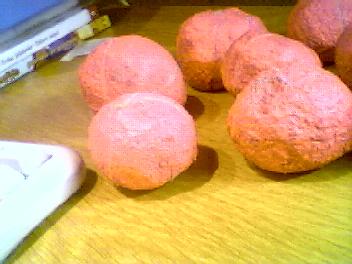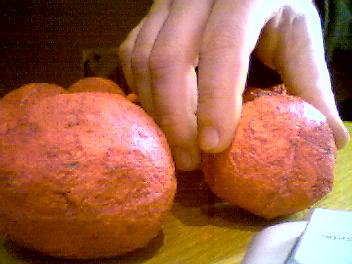Post by justbarak on Jan 13th, 2004 at 10:18pm
I was wondering the same thing about the almond shape - that it might possibly provid grip in the sling to increase spin when it is released. The same thing is done to the drill in a bow drill for making fire without matches. The drill is given an oval shape or edges in order to provide a gripping surface for the bow string to grab and rotate the drill. Otherwise the string just slides without spinning the drill.
The various techniques for throwing are mentioned throughout this thread. Can someone describe them: overhand, underhand, etc? I'm assuming that a clockwise rotation (relative is the most universal ,and in that, a vertical rotation or a horizontal rotation, and then something around 45 plane of axis (the blue, green, and red circles on my little photoshop stick man slinger - the starred arrows being the rough point of release). Then there is a counter clockwise rotation as well, which I imagine is only used in a vertical spin. What purpose is a cc throw? Is it accurate at all (I only use it for spelunking frogs in the pond out back ;D)
Just imagining the throws, it seems like the clockwise 45 degree rotation would release the projectile in a more pointed position rather than totally broadside. But I'm not sure. I need to make another sling and try it out. In PNG (Papua New Guinea) down in the Sepik flood basin where there are no rocks but lots of clay the village kids made clay shot which they dried in the sun. It was round. Not that they are as advanced as the Romans were :)
Barak
The various techniques for throwing are mentioned throughout this thread. Can someone describe them: overhand, underhand, etc? I'm assuming that a clockwise rotation (relative is the most universal ,and in that, a vertical rotation or a horizontal rotation, and then something around 45 plane of axis (the blue, green, and red circles on my little photoshop stick man slinger - the starred arrows being the rough point of release). Then there is a counter clockwise rotation as well, which I imagine is only used in a vertical spin. What purpose is a cc throw? Is it accurate at all (I only use it for spelunking frogs in the pond out back ;D)
Just imagining the throws, it seems like the clockwise 45 degree rotation would release the projectile in a more pointed position rather than totally broadside. But I'm not sure. I need to make another sling and try it out. In PNG (Papua New Guinea) down in the Sepik flood basin where there are no rocks but lots of clay the village kids made clay shot which they dried in the sun. It was round. Not that they are as advanced as the Romans were :)
Barak





